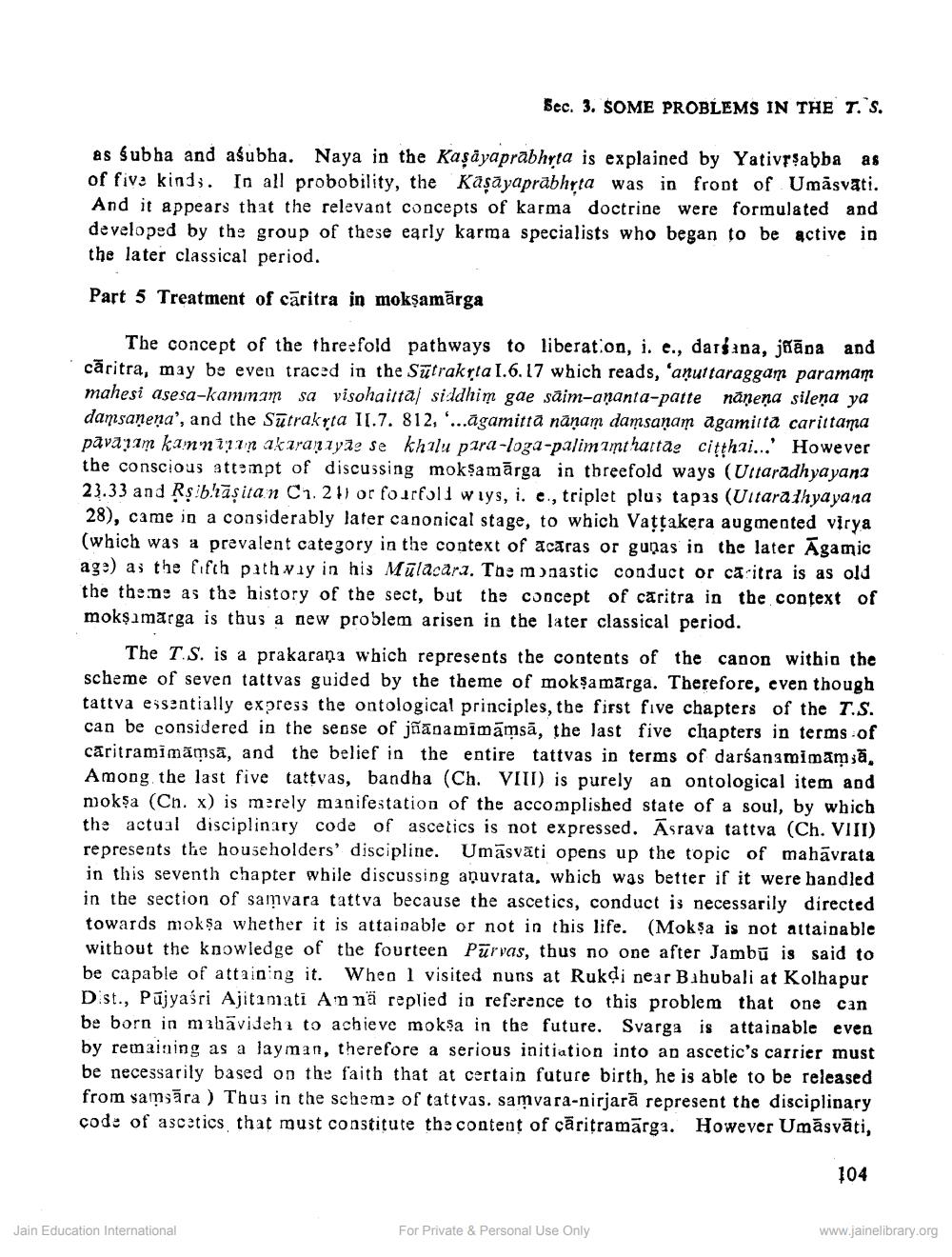________________
Bec. 3. SOME PROBLEMS IN THE T. S.
as subha and aśubha. Naya in the Kaşayaprabhyta is explained by Yativrsabba as of five kind;. In all probobility, the Kaşāyaprabhyta was in front of Umāsvati. And it appears that the relevant concepts of karma doctrine were formulated and developed by the group of these early karma specialists who began to be active in the later classical period.
Part 5 Treatment of caritra in mokşamārga
The concept of the threefold pathways to liberation, i. e., darśana, jñāna and căritra, may be even traced in the Sūtrakrta 1.6.17 which reads, 'anuttaraggam paramam mahesi asesa-kamınım sa visohaitta/ siddhim gde säim-ananta-patte näneņa silena ya damsaņeņa', and the Satrakrta 11.7. 812, ...āgamitta nāņam damsaņam agamiita carittama pavaram kann 1779 akaraiyio se khilu para-loga-palimimthatta citthai...' However the conscious attempt of discussing moksamārga in threefold ways (Uttaradhya yana 23.33 and Rs brāșitan C1.211 or fourfoli wys, i. e., triplet plus tapas (Uttaralhyayana 28), came in a considerably later canonical stage, to which Vaţtakera augmented virya (which was a prevalent category in the context of acaras or gunas in the later Agamic age) as the fifth pathway in his Mūlacăra. The monastic conduct or ca itra is as old the thens as the history of the sect, but the concept of caritra in the context of mokşımarga is thus a new problem arisen in the later classical period.
The T.S. is a prakarana which represents the contents of the canon within the scheme of seven tattvas guided by the theme of mokşamarga. Therefore, even though tattva essentially express the ontological principles, the first five chapters of the T.S. can be considered in the sease of jñanamimāmsā, the last five chapters in terms of caritramimamsa, and the belief in the entire tattvas in terms of darśanamimamsă. Among the last five tattvas, bandha (Ch. VII) is purely an ontological item and moksa (Cn. x) is merely manifestation of the accomplished state of a soul, by which the actual disciplinary code of ascetics is not expressed. Asrava tattva (Ch. VIII) represents the householders' discipline. Umāsvati opens up the topic of mahāvrata in this seventh chapter while discussing aņuvrata, which was better if it were handled in the section of samvara tattva because the ascetics, conduct is necessarily directed towards mokṣa whether it is attainable or not in this life. (Moksa is not attainable without the knowledge of the fourteen Purvas, thus no one after Jambū is said to be capable of attaining it. When I visited nuns at Rukdi near Bihubali at Kolhapur Dist., Pūjyasri Ajitamati Annä replied in reference to this problem that one can be born in malāvidehi to achieve mok$a in the future. Svarga is attainable even by remaining as a layman, therefore a serious initiation into an ascetic's carrier must be necessarily based on the faith that at certain future birth, he is able to be released from samsāra ) Thus in the schema of tattvas. samvara-nirjarā represent the disciplinary code of ascetics that must constitute the content of caritramārga. However Umāsvāti,
104
Jain Education International
www.jainelibrary.org
For Private & Personal Use Only




